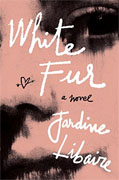White Fur
Jardine Libaire
book reviews:
· general fiction
· chick lit/romance
· sci-fi/fantasy
· graphic novels
· nonfiction
· audio books
· author interviews
· children's books @
curledupkids.com
· DVD reviews @
curledupdvd.com
newsletter
win books
buy online
links
home
for authors
& publishers
for reviewers

 |
White Fur Jardine Libaire Hogarth Hardcover 320 pages May 2017 |
|
Click here to read reviewer Luan Gaines's take on White Fur. Elise, the main character in Libaire’s White Fur
Jamey ignores the demands of his best friend, Matt, who questions whether Jamey is out of his mind in perpetuating an affair “that is not supposed to last.” Burning with shame at this “unbidden idea,” Jamey invites Elise to his family home in Newport. Feeling both exited and stupid, Elise knows the trip will be humiliating in a vague and unknown way, but she goes anyway, simultaneously threatened and attracted to Jamey’s privileged lifestyle. Soon Jamey faces tough questions, ignoring the consequences of his actions and the Hyde family legacy--despite “good talks” from Alex, his distracted investment banker father who wants Jamey to claim his blood-right, and from Tory, his beautiful movie-star mother who doesn’t know how to handle this low-class interloper who has come forward to seduce her beloved son. Encased in a loft in the East Village surrounded by car fumes, hot dog cars and newspaper stands, Elise and Jamey throw caution to the wind, at first critically observant of each other’s faults. Elise is not unaware of Jamey’s insecurities at making his own way in the world. But something has changed; she feels different. With her gray jeans, her cheap white fur coat, and her fake-gold "E" on a chain, Elise’s awkwardness is matched by strategic awareness as she basks in a vague, haughty and delicious joy. Jamey is unable to explain to her the Hyde traditions, how their pockmarked DNA “ages like blue cheese.” They’re more than a family; they’re an institution and a culture that revolves around whiskey juleps at the Kentucky Derby and summer croquet at the Hamptons. The pressures from Jamey’s family, coupled with the struggle to survive in a Manhattan laden with parties, drugs, feasts and cold streets rich with snow, place a significant strain on a relationship that neither Jamey or Else can navigate in adequate fashion. Yet once they commit to each other, the novel begins its shift into Jamey’s rush to escape from the machinations of the Hydes: from family matriarch Binkie (“her rose-pink, raspy whisper doles out in endearments and greetings”) and her husband, Bats, who rules the roost like a fishmonger rules cats. Binkie and Bats’s stunning gift for manipulation accelerates the novel towards its inevitable showdown. Libaire’s writing is seductive and unique, reflecting the decadence and struggles of '80s-era big city life. I can see how readers would either love or hate this book. I loved the experience of not knowing whether Libaire’s star-crossed lovers will survive in a world that brushes past Elise’s charms while surrendering to Jamey’s fears. Jamey sees himself as someone who can slip silently through the crowd at Grand Central, “trespassing on land that belongs to better people.” Love, he thinks, is accidental and fleeting; he can’t possibly deserve a girl like Elise. On the other hand, Elise navigates by faith; she deeply believes in the purity of love even if she thinks it doomed from the start. When she sees Jamey for the first time, Elise recognizes him as a kindred spirit of sorts. Elise moves though the bright, spangled Manhattan nights, wondering how to make Jamey love her more--enough to banish the family shadows that haunt him. Exploring the class divide through the prism of love, marriage, and personal sacrifice, White Fur Originally published on Curled Up With A Good Book at www.curledup.com. © Michael Leonard, 2017 |
|
|
|
 Click here to learn more about this month's sponsor! |
|
| fiction · sf/f · comic books · nonfiction · audio newsletter · free book contest · buy books online review index · links · · authors & publishers reviewers |
|
| site by ELBO Computing Resources, Inc. | |
 Libaire’s unconventional writing style forms the core of
Libaire’s unconventional writing style forms the core of